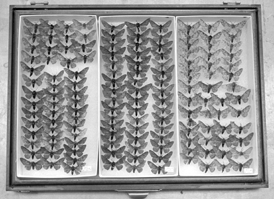The University Record, November 26, 1996
Moths become media stars 
Meet the University’s latest media stars. This collection of Biston betularia cognataria, hidden away for the past 16 years in a drawer at the U-M Museum of Zoology, made the front page of the New York Times science section Nov. 12. The moths were collected from 1959 to 1962 at the U-M’s George Reserve near Pinckney by British biologist and former U-M graduate student Denis Owen.
In an article published in a recent issue of The Journal of Heredity, Owen and his co-authors used the U-M moths to validate a classic example of natural selection in evolutionary biology. Owen compared the American moths with the same species collected during the same time period near Liverpool, England.
In both countries, the researchers found that black varieties were much more common in the late 50s and early 60s, while peppered varieties predominated in the 1990s. The change in moth coloration patterns paralleled changes in air pollution from the 1950s to the 1990s, which took place in Liverpool and Detroit after England and the U.S. adopted clean-air standards. When trees and buildings were covered with black soot in the late 1950s, black moths were less visible to birds and so become more prevalent in the total moth population. As both countries cleaned up their urban environments, dark moths became more likely to be spotted by hungry birds. Peppered moths were less noticeable, which is why they make up the majority of today’s moth population.
Photo by Bob Kalmbach

